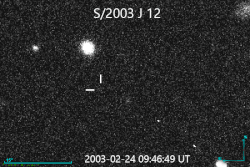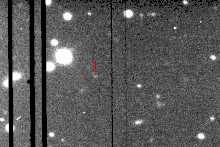S/2003 J 12
S/2003 J 12 is a natural satellite of Jupiter, and is one of the smallest known natural satellites in the Solar System. It was discovered by a team of astronomers from the University of Hawaii led by Scott S. Sheppard in 2003.[4][1]
 S/2003 J 12 imaged by the Canada-France-Hawaii Telescope during follow-up observations in February 2003 | |
| Discovery [1] | |
|---|---|
| Discovered by | Scott S. Sheppard et al. |
| Discovery site | Mauna Kea Obs. |
| Discovery date | 8 February 2003 |
| Orbital characteristics [2] | |
| Epoch 17 December 2020 (JD 2459200.5) | |
| Observation arc | 9.65 yr (3,525 d) |
| Earliest precovery date | 10 December 2001 |
| 0.1441046 AU (21,557,740 km) | |
| Eccentricity | 0.3657005 |
| –1.77 yr (–646.64 d) | |
| 295.36521° | |
| 0° 33m 24.215s / day | |
| Inclination | 154.69036° (to ecliptic) |
| 127.52296° | |
| 86.84711° | |
| Satellite of | Jupiter |
| Group | Ananke group |
| Physical characteristics | |
Mean diameter | ≈1 km[3] |
| Albedo | 0.04 (assumed)[3] |
| 23.9[3] | |
| 17.0[2] | |
S/2003 J 12 is about 1 kilometre (0.6 miles) in diameter, and orbits Jupiter at an average distance of 21,600 Mm in 647 days, at an inclination of 155° to the ecliptic, in a retrograde direction and with an eccentricity of 0.366.[2] It was initially thought to the innermost of the retrograde satellites of Jupiter, but recovery observations have shown that it is an ordinary member of the Ananke group.[5]


This moon was considered lost[6][7][8][9] until late 2020, when it was recovered in archival CFHT images from 2001-2011 by an amateur astronomer under the name Kenneth.[5] The recovery of the moon was announced by the Minor Planet Center on 13 January 2021.[2]
References
- MPEC 2003-E29: S/2003 J 9, 2003 J 10, 2003 J 11, 2003 J 12; S/2003 J 1, 2003 J 6 April 3, 2003 (discovery and ephemeris)
- "MPEC 2021-A169 : S/2003 J 12". Minor Planet Electronic Circular. Minor Planet Center. January 13, 2021. Retrieved January 13, 2021.
- S.S. Sheppard (2019), Moons of Jupiter, Carnegie Science, on line
- Daniel W. E. Green (March 7, 2003). "IAUC 8089: Satellites of Jupiter". International Astronomical Union.
- Hecht, Jeff (January 11, 2021). "Amateur Astronomer Finds "Lost" Moons of Jupiter". www.skyandtelescope.com. Sky & Telescope. Retrieved January 11, 2021.
- Beatty, Kelly (April 4, 2012). "Outer-Planet Moons Found — and Lost". www.skyandtelescope.com. Sky & Telescope. Retrieved June 27, 2017.
- Brozović, Marina; Jacobson, Robert A. (March 9, 2017). "The Orbits of Jupiter's Irregular Satellites". The Astronomical Journal. 153 (4): 147. Bibcode:2017AJ....153..147B. doi:10.3847/1538-3881/aa5e4d.
- Jacobson, B.; Brozović, M.; Gladman, B.; Alexandersen, M.; Nicholson, P. D.; Veillet, C. (September 28, 2012). "Irregular Satellites of the Outer Planets: Orbital Uncertainties and Astrometric Recoveries in 2009–2011". The Astronomical Journal. 144 (5): 132. Bibcode:2012AJ....144..132J. doi:10.1088/0004-6256/144/5/132.
- Sheppard, Scott S. (2017). "New Moons of Jupiter Announced in 2017". home.dtm.ciw.edu. Retrieved June 27, 2017.
We likely have all of the lost moons in our new observations from 2017, but to link them back to the remaining lost 2003 objects requires more observations a year later to confirm the linkages, which will not happen until early 2018. ... There are likely a few more new moons as well in our 2017 observations, but we need to reobserve them in 2018 to determine which of the discoveries are new and which are lost 2003 moons.